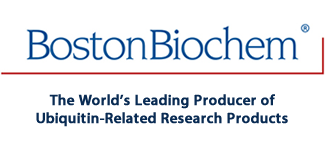
AQUApure Di-Ub Chains (K48-linked) Protein, CF Summary
Ub-AQUA analysis:
K48: 99.31%
K11: 0.36%
K63: 0.19%
K6 :0.09%
All other linkages ≤ 0.03%
Ubiquitin chains vary in length, linkage, and function. K48-linked Di-Ubiquitin Chains (Ub2) are ideal for investigating Ubiquitin-binding proteins and as substrates for Ubiquitin-specific isopeptidases. Reaction conditions will need to be optimized for each specific application. IMPORTANT: Heating this product in SDS-PAGE buffer or terminating reactions containing this product with heated SDS-PAGE buffer could lead to unexpected, high apparent molecular weight banding or smearing on gels that is not representative of product purity. For optimal results, we recommend incubation in SDS-PAGE buffer + DTT at <40 °c="" for="" 20="" minutes="" prior="" to="" gel="">
Product Datasheets
Carrier Free
CF stands for Carrier Free (CF). We typically add Bovine Serum Albumin (BSA) as a carrier protein to our recombinant proteins.Adding a carrier protein enhances protein stability, increases shelf-life, and allows the recombinant protein to be stored at a more dilute concentration.The carrier free version does not contain BSA.
In general, we advise purchasing the recombinant protein with BSA for use in cell or tissue culture, or as an ELISA standard.In contrast, the carrier free protein is recommended for applications, in which the presence of BSA could interfere.
UC-200B
| Formulation | 1 mg/ml (58 μM) in sterile, deionied water |
| Shipping | The product is shipped with polar packs. Upon receipt, store it immediately at the temperature recommended below. |
| Stability & Storage: | Use a manual defrost freezer and avoid repeated freeze-thaw cycles.
|
Reconstitution Calculator
Background: Di-Ubiquitin
Linkage specific Poly-Ubiquitin chains may be used as a substrate for in vitro reactions with deubiquitinating enzymes ("DUB"s") that cleave the peptide or isopeptide linkage between adjacent Ubiquitin molecules. Poly-Ubiquitin chains can also be used to investigate mechanisms of binding and recognition between the chains and other proteins that contain Ubiquitin-Associated domains (UBAs), Ubiquitin-interacting motifs (UIMs), ZnF"s and/or other Ubiquitin-sensing elements.
K48-linked Di-Ubiquitin chains are manufactured using recombinant Ubiquitin and purely enzymatic techniques to avoid the potential for contaminating synthetic intermediates. The correctness of linkage and purity of each production lot is assessed using the Absolute Quantitation of Ubiquitin method (Ub-AQUA), an LCMS-based technique that provides extremely accurate information on the composition of Poly-Ubiquitin samples.
- Kirkpatrick D.S., et al. (2006) Nat Cell Biol. 8: 700
- Ordureau, A., et al. (2014) Mol. Cell 56: 360
- Ordureau, A., et al. (2015) Pro. Nat. Acad. of Sci. USA 112: 6637
- Phu L., et al. (2011) Mol Cell Proteomics 10: M110.003756
- Wall C.E. et al. (2019) Cell Reports 29: 3280
Citations for AQUApure Di-Ub Chains (K48-linked) Protein, CF
R&D Systems personnel manually curate a database that contains references using R&D Systems products.The data collected includes not only links to publications in PubMed,but also provides information about sample types, species, and experimental conditions.
10Citations: Showing 1 - 10Filter your results:
Filter by:
- USP52 acts as a deubiquitinase and promotes histone chaperone ASF1A stabilizationAuthors: S Yang, L Liu, C Cao, N Song, Y Wang, S Ma, Q Zhang, N Yu, X Ding, F Yang, S Tian, K Zhang, T Sun, J Yang, Z Yao, S Wu, L ShiNat Commun, 2018;9(1):1285.Applications: Bioassay
- Reactive-site-centric chemoproteomics identifies a distinct class of deubiquitinase enzymesAuthors: DS Hewings, J Heideker, TP Ma, AP AhYoung, F El Oualid, A Amore, GT Costakes, D Kirchhofer, B Brasher, T Pillow, N Popovych, T Maurer, C Schwerdtfe, WF Forrest, K Yu, J Flygare, M Bogyo, IE WertzNat Commun, 2018;9(1):1162.Species: HumanSample Types: ProteinApplications: Bioassay
- ZUFSP Deubiquitylates K63-Linked Polyubiquitin Chains to Promote Genome StabilityAuthors: P Haahr, N Borgermann, X Guo, D Typas, D Achuthanku, S Hoffmann, R Shearer, TK Sixma, N MailandMol. Cell, 2018;0(0):.Species: HumanSample Types: Cell LysatesApplications: Bioassay
- PINK1 autophosphorylation is required for ubiquitin recognitionAuthors: S Rasool, N Soya, L Truong, N Croteau, GL Lukacs, JF TrempeEMBO Rep., 2018;0(0):.Species: Insect - Tribolium castaneumSample Types: Recombinant ProteinApplications: Bioassay
- OTUD4 Is a Phospho-Activated K63 Deubiquitinase that Regulates MyD88-Dependent SignalingAuthors: Y Zhao, MC Mudge, JM Soll, RB Rodrigues, AK Byrum, EA Schwarzkop, TR Bradstreet, SP Gygi, BT Edelson, N MosammaparMol. Cell, 2018;69(3):505-516.e5.Species: HumanSample Types: Recombinant ProteinApplications: Bioassay
- Cholesterol and fatty acids regulate cysteine ubiquitylation of ACAT2 through competitive oxidationAuthors: YJ Wang, Y Bian, J Luo, M Lu, Y Xiong, SY Guo, HY Yin, X Lin, Q Li, CCY Chang, TY Chang, BL Li, BL SongNat. Cell Biol., 2017;19(7):808-819.Species: N/ASample Types: Applications: Control
- Deubiquitinase-based analysis of ubiquitin chain architecture using Ubiquitin Chain Restriction (UbiCRest).Authors: Hospenthal, Manuela, Mevissen, Tycho E, Komander, DavidNat Protoc, 2015;10(2):349-61.Species: HumanSample Types: Protein
- The ubiquitin-associated (UBA) domain of SCCRO/DCUN1D1 protein serves as afeedback regulator of biochemical and oncogenic activity.Authors: Huang G, Towe C, Choi L, Yonekawa Y, Bommelje C, Bains S, Rechler W, Hao B, Ramanathan Y, Singh BJ Biol Chem, 2015;290(1):296-309.Species: N/ASample Types: ProteinApplications: Binding Assay
- USP45 deubiquitylase controls ERCC1-XPF endonuclease-mediated DNA damageresponses.Authors: Perez-Oliva A, Lachaud C, Szyniarowski P, Munoz I, Macartney T, Hickson I, Rouse J, Alessi DEMBO J, 2015;34(3):326-43.
- The vOTU domain of highly-pathogenic porcine reproductive and respiratorysyndrome virus displays a differential substrate preference.Authors: Deaton M, Spear A, Faaberg K, Pegan SVirology, 2014;454(0):247-53.
FAQs
No product specific FAQs exist for this product, however you may
View all Proteins and Enzyme FAQsReviews for AQUApure Di-Ub Chains (K48-linked) Protein, CF
Average Rating: 4(Based on 1 Review)
Have you used AQUApure Di-Ub Chains (K48-linked) Protein, CF?
Submit a review and receive an Amazon gift card.
$25/€18/£15/$25CAN/¥75 Yuan/¥1250 Yen for a review with an image
$10/€7/£6/$10 CAD/¥70 Yuan/¥1110 Yen for a review without an image
Filter by:
Silver staining was used to determine the location of di-ub or mono-ub.

ebiomall.com






>
>
>
>
>
>
>
>
>
>
>
做的比较好的,一般都是上海地区的,你可以看下基尔顿生物。
要想买几个金属浴,没有特殊要求,只要体积小、请便易携就行。最好是国内主流牌子,样子要好看点的。进口的太贵了。
想H2O3系列的,天根什么的靠谱吗
知识范围广,生物学基础强,工科知识扎实,二者有机结合.
基础扎实,应用广泛,可以很容易的转到生物科学方向或其他相关应用专业,比如食品科学,制药科学 .
理性思维强,善于分析问题解决问题;注重动手操作能力,可以进行独立课题实验,并提交专业论文.
保研考研比率很大,很多学生有机会出国继续深造 .2.劣势
专业课设置不是很成熟,各学校参差不齐.
生物科学专业课和工科知识学习均深度有限 .
所要求的科目较多,课业较重,想要学好学精必须投入大量精力,所以课余时间不是很充足.
本科毕业工作前景不是十分明朗,相关就业领域要求更高学历.3.挑战
相对口专业要求更高学历,本科毕业后工作相对难找,为此很多学生进一步深造学习,就业的一般从事层次较低的技术工作或干脆放弃本专业而转行.
如果有志与从事相关科研工作,需要培养扎实的钻研探索精神,并注重锻炼动手能力,进一步深造学习,定会成为该方面的高级科学人才.4.机遇
培养高级科研和技术人才学科,出国比例大,各大有名高校都十分注重其发展.
专业适用面广,易转专业,可以进一步学习上游的生命科学,也可以学习下游的实用工程学科.就业领域广泛,比如制药,食品,科研,或技术开发等.
把先进高端的生命科学和应用联系起来,是非常火的专业,前景十分看好.出路1.读研
读研比例很大,若想要在本学科有所建树或想从事高级技术工作必须读研进一步深造,一般有一半以上的学生会选择读研.
读研选择余地打,可以转向很多相关领域,如生物,制药,食品等;保研几率比较大,且各学校,各科研院所交叉保送机会很大 .
读研如选择生命科学类,则向理科研究方向发展,一般会一直从事研究工作,如继续本专业或转向发酵工程,制药工程,食品科学等,硕士毕业后会有很好的就业前景.2.出国
生物工程属于综合交叉发展学科,且与应用有紧密的结合,国外很多著名大学都很注意其发展,所以出国深造机遇很大,也会有更大的发展空间.
可以转向学习生命科学,这方面在国外有更先进的发展研究,我国的著名高校一般都与国外大学建立了友好交流关系,会推荐此类专业的很多学生出国学习 .
如果转专业学习与工程联系紧密的学科,如食品发酵等,荷兰,日本等国家也是比较理想的去处 .3.找工作
适宜于医药、食品、环保、商检等部门中生物产品 的技术开发、工程设计、生产管理及产品性能检测分析等工作及教学部门的研究与教学工作 .
本科生直接从事科研方面工作的可能性不大,部分毕业生转向其它行业,部分毕业生从事相关专业的下游技术工作.
毕业直接在医药,食品等方向就业,工作内容一般较单调的技术工作,且需要进一步的经验积累和实践操作能力培养 .未来发展方向
相关研究所:中国科学院生物工程研究中心、清华大学生物工程、北京协和生物工程研究所等.
相关公司:华美生物工程公司,北京市百赛生物工程公司,中国生物工程公司,北京生物工程公司,上海生物工程公司等.









